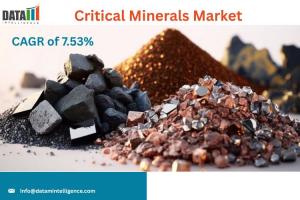Critical Minerals Market Growth 2025 | Global Demand, Trends & Opportunities | DataM Intelligence
The Global Critical Minerals Market is expected to reach at a CAGR of 7.53% during the forecast period 2025-2032.
Market Overview:
Critical minerals like lithium, cobalt, rare earth elements (REEs), nickel, graphite, manganese, tungsten, and copper are essential for producing electric vehicles (EVs), renewable energy technologies, consumer electronics, aerospace and defense systems, and industrial machinery. The growing demand for these minerals is primarily driven by the worldwide transition toward sustainable energy solutions.
The International Energy Agency (IEA) reports that mineral demand for clean energy technologies is projected to nearly quadruple by 2040, with lithium demand expected to increase nine fold. Copper, a vital component in electrification, is anticipated to see the largest absolute growth, with clean energy applications accounting for over 40% of total demand for copper and REEs, 60–70% for nickel and cobalt, and nearly 90% for lithium.
Download Sample Report Here: https://www.datamintelligence.com/download-sample/critical-minerals-market
Market Drivers and Opportunities:
The following are the main factors driving the critical minerals market's expansion:
Energy Transition Technologies: The shift towards EVs, solar panels, wind turbines, and energy storage systems is driving the demand for critical minerals.
Geopolitical Dynamics: Efforts to diversify supply chains and reduce dependence on dominant producers are fostering international collaborations and investments.
Technological Advancements: Innovations in recycling, alternative materials, and mining technologies are enhancing supply chain resilience and sustainability.
Opportunities abound in regions rich in mineral resources, including parts of Africa, Latin America, and Asia-Pacific, as countries seek to develop and secure their critical mineral supplies.
Market Segmentation:
By Mineral Type:
Lithium
Cobalt
Rare Earth Elements (REEs)
Nickel
Graphite
Manganese
Tungsten
Copper
Others.
By Extraction Method:
Primary Mining
Secondary Recycling (Urban / End-of-life Products)
Brine Extraction
Ore Processing
Others.
By Application:
Electric Vehicles (EVs)
Renewable Energy
Consumer Electronics
Aerospace & Defense
Industrial Machinery
Energy Storage Systems
Others.
By Region:
North America
South America
Europe
Asia Pacific
Middle East
Africa.
Geographical Market Share:
The critical minerals market is geographically diverse, with significant contributions from:
North America: The U.S. is focusing on domestic production, with companies like MP Materials leading efforts to establish a fully integrated rare earth magnet manufacturing facility in Texas.
Asia-Pacific: Japan is investing in diversified supply chains and recycling technologies to reduce reliance on imports, while South Korea is expanding its eco-friendly vehicle market and exploring new export markets.
Africa and Latin America: Countries like the Democratic Republic of Congo are engaging in international partnerships to develop their mineral resources, aiming to reduce dependence on dominant suppliers.
Key Players:
Prominent companies in the critical minerals market include:
Albemarle Corporation
Livent Corporation
Lynas Rare Earths Limited
MP Materials Corp.
Glencore plc
Iluka Resources Limited
Rio Tinto Group
Pilbara Minerals Limited
Canada Nickel Company Inc.
Recent Developments:
United States (2024–2025):
Expansion of Rare Earth Magnet Production: In January 2025, MP Materials began producing neodymium and praseodymium (NdPr) metal at its Fort Worth, Texas facility, marking the first time rare earth magnets are processed in the United States.
International Partnerships: In May 2025, MP Materials entered an agreement with Saudi Arabian Mining Company (Ma'aden) to establish a rare earth supply chain in Saudi Arabia, reflecting the United States' strategic goals to diversify its mineral supplies.
Japan (2024–2025):
Diversification of Dysprosium Supply Chains: Japan is collaborating with rare earth miners in Australia, the United States, and Vietnam to mitigate supply disruptions and geopolitical risks associated with dysprosium, a critical component for electric vehicles and renewable energy technologies .
Advancements in Recycling Technologies: Japan is investing in the development of advanced recycling facilities to efficiently recover rare earth metals from electronic waste, aiming to reduce import dependency and enhance sustainability .
Stay informed with the latest industry insights-start your subscription now: https://www.datamintelligence.com/reports-subscription
Conclusion:
The critical minerals market is at a pivotal juncture, with nations worldwide recognizing the strategic importance of securing reliable and sustainable supplies. Through international collaborations, technological innovations, and policy initiatives, countries are positioning themselves to meet the growing demand for these essential resources, ensuring a resilient foundation for the global energy transition.
Related Reports:
Precious Metal Market
Green Steel Market
Sai Kiran
DataM Intelligence 4Market Research
+1 877-441-4866
Sai.k@datamintelligence.com
Visit us on social media:
LinkedIn
X
Legal Disclaimer:
EIN Presswire provides this news content "as is" without warranty of any kind. We do not accept any responsibility or liability for the accuracy, content, images, videos, licenses, completeness, legality, or reliability of the information contained in this article. If you have any complaints or copyright issues related to this article, kindly contact the author above.
Hi-Speed Announces Significant Growth in Motor Shop Capabilities with New Electrical Test Panel
Let Her Sing® 2025 Carries On: Diaspora Arts Connection Moves Forward Despite Travel Ban Setback
Japan’s Diabetes Digital Therapeutics Market to Reach USD 136.4 Mn by 2033 with Strong Adoption | DataM Intelligence
Więcej ważnych informacji
 Jedynka Newserii
Jedynka Newserii

 Jedynka Newserii
Jedynka Newserii

Ochrona środowiska

A. Bryłka (Konfederacja): Ograniczenie emisyjności nie musi się odbywać za pomocą celów klimatycznych. Są absurdalne, nierealne i niszczące europejską gospodarkę
W lipcu br. Komisja Europejska ogłosiła propozycję nowego celu klimatycznego, który zakłada ograniczenie emisji gazów cieplarnianych o 90 proc. do 2040 roku w porównaniu do stanu z 1990 roku. Został on zaproponowany bez zgody państw członkowskich, w przeciwieństwie do poprzednich celów na 2030 i 2050 rok. Polscy europarlamentarzyści uważają ochronę środowiska i zmiany w jej zakresie za potrzebne, jednak nie powinny się odbywać za pomocą nieosiągalnych celów klimatycznych.
Polityka
Dramatyczna sytuacja ludności w Strefie Gazy. Pilnie potrzebna dobrze zorganizowana pomoc humanitarna

Według danych organizacji Nutrition Cluster w Strefie Gazy w lipcu br. u prawie 12 tys. dzieci poniżej piątego roku życia stwierdzono ostre niedożywienie. To najwyższa miesięczna liczba odnotowana do tej pory. Mimo zniesienia całkowitej blokady Strefy Gazy sytuacja w dalszym ciągu jest dramatyczna, a z każdym dniem się pogarsza. Przedstawiciele Polskiej Akcji Humanitarnej uważają, że potrzebna jest natychmiastowa pomoc, która musi być dostosowana do aktualnych potrzeb poszkodowanych i wsparta przez stronę izraelską.
Polityka
Wśród Polaków rośnie zainteresowanie produktami emerytalnymi. Coraz chętniej wpłacają oszczędności na konta IKE i IKZE

Wzrosła liczba osób, które oszczędzają na cele emerytalne, jak również wartość zgromadzonych środków. Liczba uczestników systemu emerytalnego wyniosła w 2024 roku ponad 20,8 mln osób, a wartość aktywów – 307,5 mld zł – wynika z najnowszych danych Urzędu Komisji Nadzoru Finansowego (UKNF). Wyraźny wzrost odnotowano w przypadku rachunków IKE i IKZE, na których korzyść działają m.in. zachęty podatkowe. Wpłacane na nie oszczędności są inwestowane, a tym samym wspierają gospodarkę i mogą przynosić atrakcyjną stopę zwrotu.
Partner serwisu
Szkolenia

Akademia Newserii
Akademia Newserii to projekt, w ramach którego najlepsi polscy dziennikarze biznesowi, giełdowi oraz lifestylowi, a także szkoleniowcy z wieloletnim doświadczeniem dzielą się swoją wiedzą nt. pracy z mediami.








.gif)

 |
| |
| |
|